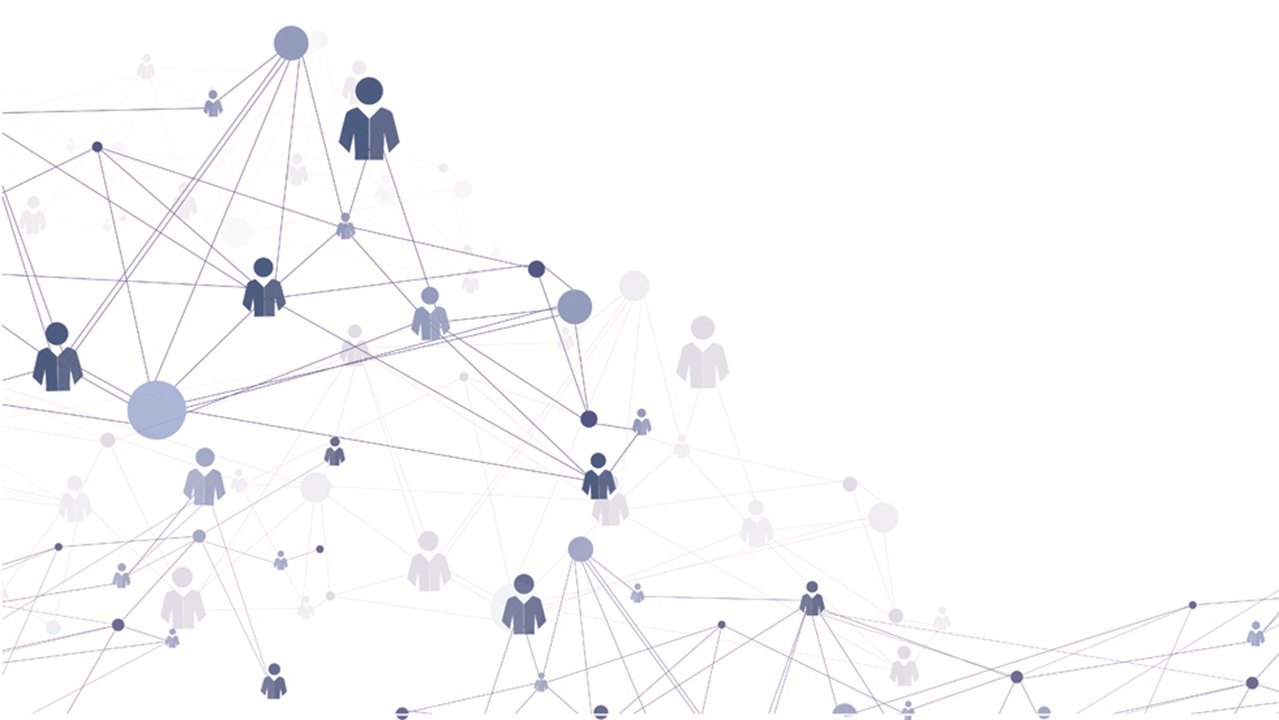
Recruiting and retaining talented employees to work in the public sector has been a challenge in both strong and struggling economies. So, what’s going on in 2025?
According to the latest workforce data from MissionSquare Research Institute, the hiring difficulties of the past few years have lessened considerably, although they have not gone away.
The institute’s annual workforce survey, conducted in collaboration with the Public Sector HR Association and the National Association of State Personnel Executives, has polled human resources managers since 2009. This article focuses on some of the longer-term trends related to talent management.
Recruitment Challenges
Hard-to-fill positions have been a focus of the survey since its inception. From 2012 to 2014, only information technology and engineering positions saw even a tenth of respondents indicate they were a challenge. Those difficulties grew to impact more governments and more positions through 2020, ballooned with the onset of the pandemic, and have declined since 2022. (See Figure 1.) As of 2025, only engineering positions are considered hard to fill by more than 70% of respondents.
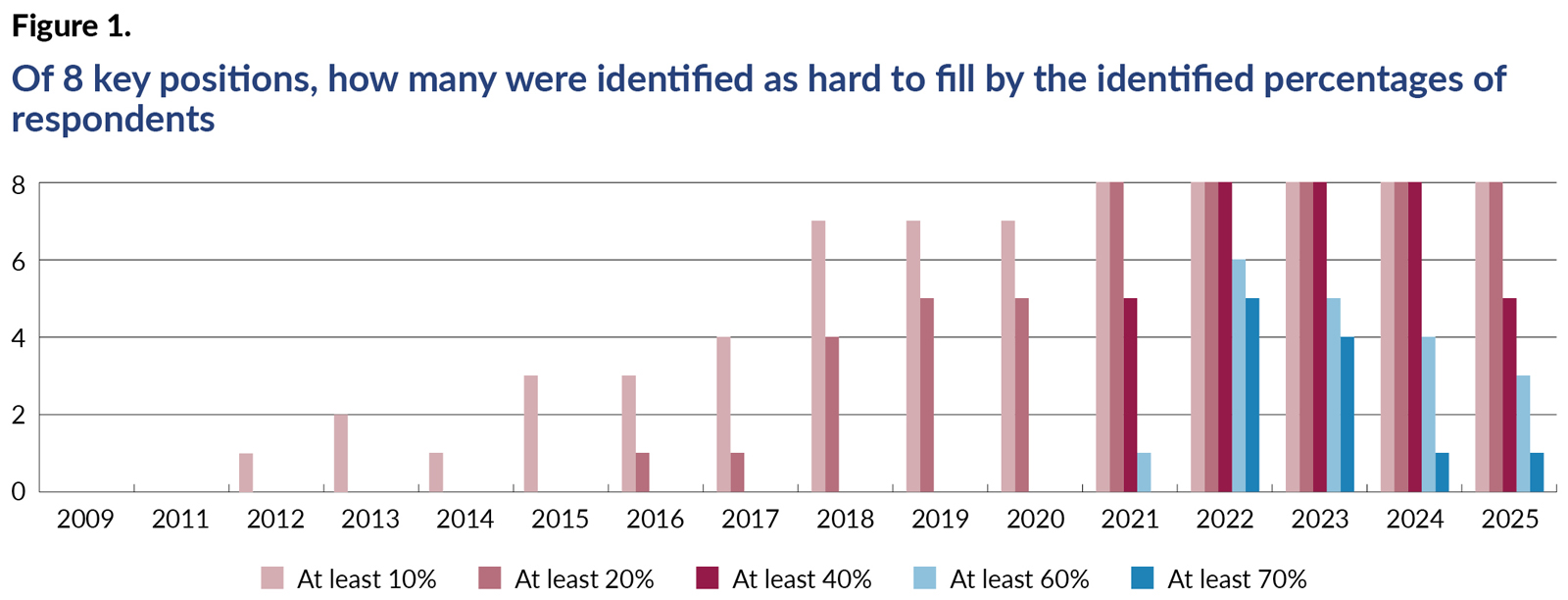
Figure 2 reflects data for information technology, engineering, police, dispatch, maintenance work, finance, and building permitting and inspections. Data for corrections and nursing was excluded as it was not available in all years.
But just because recruitment is easier now does not mean that it is easy. This is illustrated by the fact that many of those positions receive fewer qualified applicants than they have vacant positions available to fill. While this metric also shows signs of improvement, IT and maintenance positions have fewer than half of respondents saying that they are not receiving enough qualified candidates
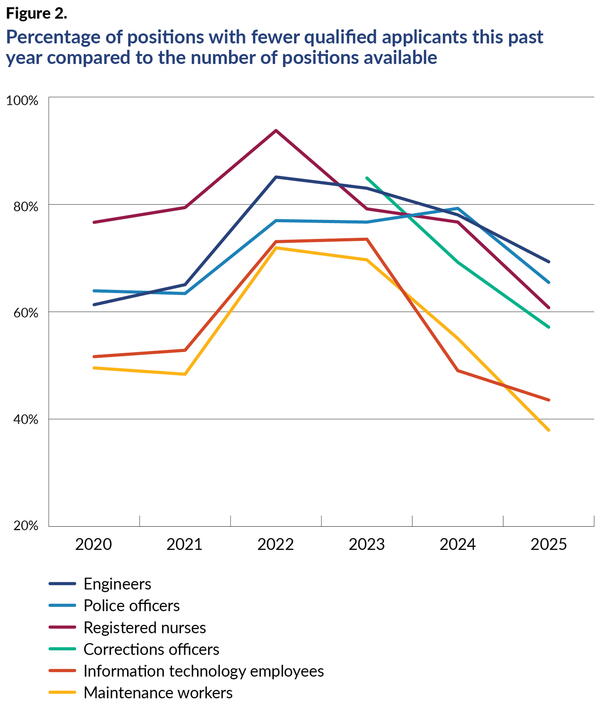
Compensation
Factors that may be contributing to this improvement include the waning of the pandemic and the Great Resignation. In addition, inflation over the past few years coincided with a decreased perception that public sector wages were competitive. (See Figure 3, 2022).
From 2023 to 2025, it was common for governments to conduct compensation and classification studies and then to offer broad-based pay increases. And permanent salary adjustments aside, about a third of respondents across those three years indicated that they were offering targeted hiring bonuses.
The attention to such compensation issues can be seen in both lines in Figure 3 trending upward after 2022.
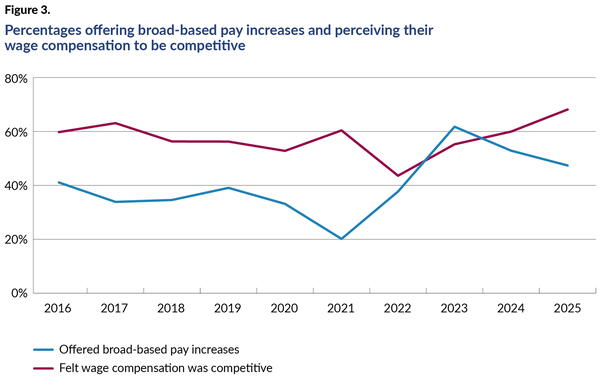
Retirements
The labor supply is also worth considering, and several trends are overlapping here. As noted, the Great Resignation has waned, with the quit rate among state and local government employees reaching a 20-year high in 2021through 2022 and since returning to pre-pandemic levels.
At the same time, the Baby Boom generation has hit “peak 65,” which means a large segment of the workforce has reached retirement age. And considering that the state and local workforce has a higher median age than the workforce as a whole,1 the coming loss of talent looms large. In fact, 46% of survey takers anticipate the largest number of anticipated retirements will hit their organizations in the next few years.
Federal Workers
For those looking to respond to this silver tsunami of retirees with a silver bullet fix, it is tempting to see that in the number of federal workers who have either been displaced by recent layoffs and incentivized resignations, or who are just looking to explore other options. In fact, there is evidence that those federal workers are open to that path, with Work for America finding that 52% are interested in applying to state or local government as a means of continuing their careers in public service.
However, interest does not necessarily translate into a convenient fit. Geography will play a role. Although many federal workers are already based outside the Washington area, they may not be located close to where jobs are available or be willing to move to smaller or rural locations even within their current states of residence. Their skill sets and specializations also may not align with the vacancies available, though they are more likely to align for positions in IT or finance. Likewise, agents in the Federal Bureau of Investigation might see opportunities with larger state or local policing agencies. For others, there may be more of a mismatch, such as moving from a focus on national-scale crime interdiction to patrol and investigations in small to mid-sized communities.
In addition, the federal departments impacted (e.g., U.S. Agency for International Development, National Oceanic and Atmospheric Administration, National Science Foundation) may not be the prime source of job candidates for jurisdictions struggling to fill vacancies among public safety dispatchers, public health nurses, corrections officers, or building inspectors.
The data so far reflect this. With the workforce survey taking place from March 4 to April 7, 2025, very few local governments (0.3%) indicated that outreach to federal workers was among their successful recruitment strategies. This was much more common among state governments (11%). As the long-term impacts of federal job cuts are felt through the remainder of 2025 and beyond, it is expected that the 2026 survey will reflect an increasing emphasis on such recruiting.
Other Workforce Issues
Of course, changes to the labor market have not been limited to compensation or federal employment. Among the other high profile issues impacting recruitment and retention are skill-based recruiting, flexible work practices, and policy and practice around diversity, equity, and inclusion (DEI).
Skill-based Recruiting
Related to the compensation and classification studies that have been conducted has been a reconsideration of college degree or other requirements for various positions. This may be due to the changing nature of the jobs or to alternate pathways that exist for candidates to acquire relevant experience.
For the past three years, at least 40% reported that they had updated job specifications for minimum education, skills, or licensing. This may be a method of lowering barriers to applications—and 72% indicated that they have seen an increase in applications following such changes—but it may also be paired with efforts to put in place either pre-employment skills assessment tools (reported by 9%), programs to upskill new employees after they have been hired (18%), or internships or apprenticeships across a wide range of positions (18%). Apprenticeships were most commonly cited among utilities staff, but were also reported in skilled trades, information technology, and other fields.
Flexible Work Practices
“Return to the office” has been a mantra around large corporations as well as some metro areas and state governments. Exclusively remote work has declined since its peak in 2021, but it remains one part of the overall staffing landscape, with 13% offering that to some share of their eligible employees. (See Figure 4.)

What seems to have replaced it is hybrid staffing, which declined slightly from its 2024 peak but is currently in place in 54% of organizations, often with shared in-office days for optimal collaboration opportunities (a practice followed by 61% of those with a hybrid schedule). Despite the churn among full-time remote and hybrid work, flexible schedules and hours remain as common as they were back in 2016, and the percentage with no flexible work arrangements continues to hover around 20%.
Diversity, Equity, and Inclusion
One subject on which there is amazing diversity is the range of definitions ascribed to DEI. This article will not add one more definition to that ongoing dialogue but will share what the data shows.
As an organizational priority, the importance of DEI to state and local governments has decreased. From 2021 through 2023, the survey asked about DEI as part of a list of potential priorities, asking that they be identified as important, somewhat important, or not important. In the wake of social justice movements in 2020, DEI was identified as important by 64% of local governments. That total declined to 56% by 2023. (See Figure 5.)
In 2024, the question was reformatted to ask only about “very important” priorities. As a result, while the 40% ranking workforce DEI as “very important” in 2024 should not be compared to the figures in 2021–2023, there was a clear decline from 2024 to 2025 (down to 27% identified as “very important”).
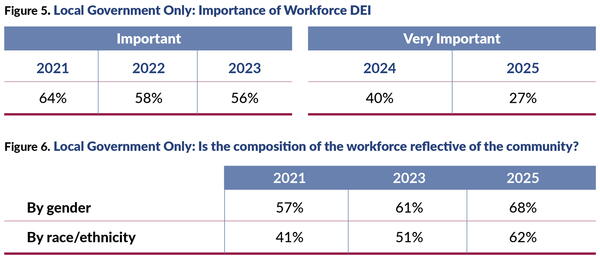
That does not mean, however, that there is less diversity in the workforce. In fact, diversity appears to have increased, as seen in Figure 6. As with the improvements in recruitment environment, there may have been multiple factors that contributed to this change. For instance:
• The difficulty in recruiting may have spurred new or expanded outreach.
• Staff who had been hired at a time when the local labor market was less diverse may have resigned or retired during the pandemic years, and new job seekers hired since that time may have been more likely to reflect current community demographics.
• Policies intended to limit potential bias (e.g., using diverse interview panels and redacting names from initial application review, reported in 2024 by 43% and 23% of local governments), may have led to consideration of more qualified, diverse applicants.
In the current policy environment, many governments may be re-evaluating the structure of their workforce DEI programs. But if the goal is to attract a pool of qualified applicants that is as wide as possible and to retain those already in the organization, then fairness and engagement will continue to be priorities, and whether as an explicit goal or as a byproduct, diversity will likely follow.
Conclusion
Just because recruitment challenges have abated somewhat does not mean that uncertainty around all these moving parts impacting workforce planning will go away. Employers can stand ready to address these issues organizationally and within individual departments. And as these laboratories of democracy continue to generate interesting ideas and approaches, those solutions will percolate throughout associations like ICMA.
For more detail around each of these topics—as well as issues like employee engagement, exit interviews, gig hiring, health and retirement benefits, and paid family leave—see the full report on the 2025 State and Local Government Workforce Survey, as well as the institute’s recent report, “Artificial Intelligence in the Workforce: A Survey of State and Local Employees.”
Key Takeaways
What does this mean for local government managers?
• Recruitment challenges have eased, but a retirement wave is still looming. If your organization does not have a succession planning process in place, it should adopt one now.
• Federal workers and younger workforce entrants prioritize public service. And yet, very few state and local governments build their recruitment campaigns around the ability to contribute to the community. Appeals to what motivates job candidates may reap better results than simply advertising a vacancy.
• Flexible workplace policies are not one-size-fits-all. Experimentation ranges from hybrid arrangements to alternate start times to shorter work weeks. Encourage departments to find what works best for their staff.
• Diversity takes many forms. Aside from welcoming people to your organization regardless of race, ethnicity, or gender, also consider how opportunities can be opened up to those who come to the workforce with skills acquired through alternate pathways, with neurodiverse backgrounds, with the capacity to be upskilled after hiring, or who may be working to re-enter the workforce after a prior incarceration or adjudication.

GERALD YOUNG is a senior researcher at MissionSquare Research Institute (research.missionsq.org).
Endnote
1 U.S. Bureau of Labor Statistics, https://www.bls.gov/cps/cpsaat18b.htm. Employed Persons by Detailed Industry and Age: The median age of those employed in public administration is 44.9, compared to the overall workforce median of 42.2.
New, Reduced Membership Dues
A new, reduced dues rate is available for CAOs/ACAOs, along with additional discounts for those in smaller communities, has been implemented. Learn more and be sure to join or renew today!
